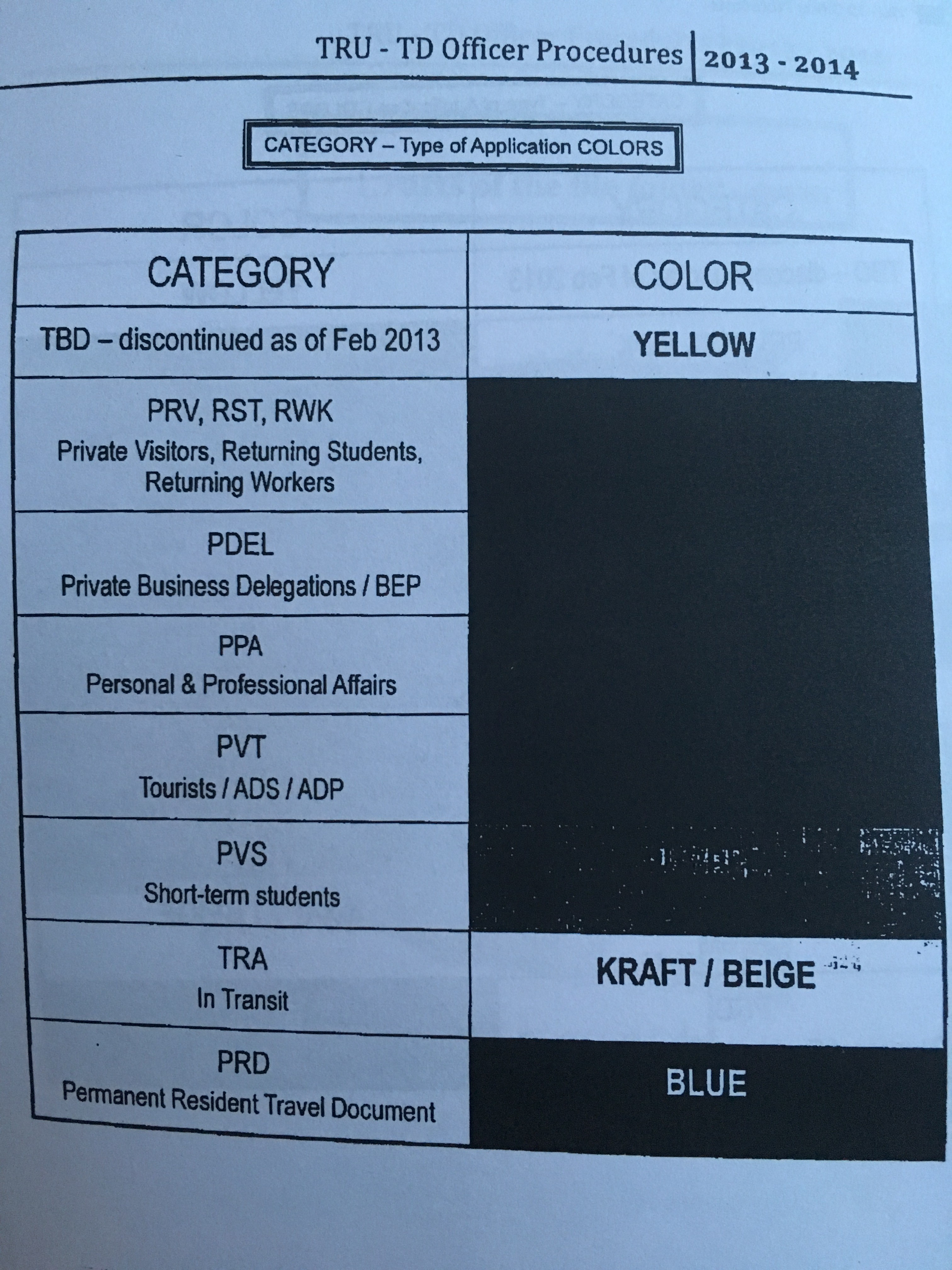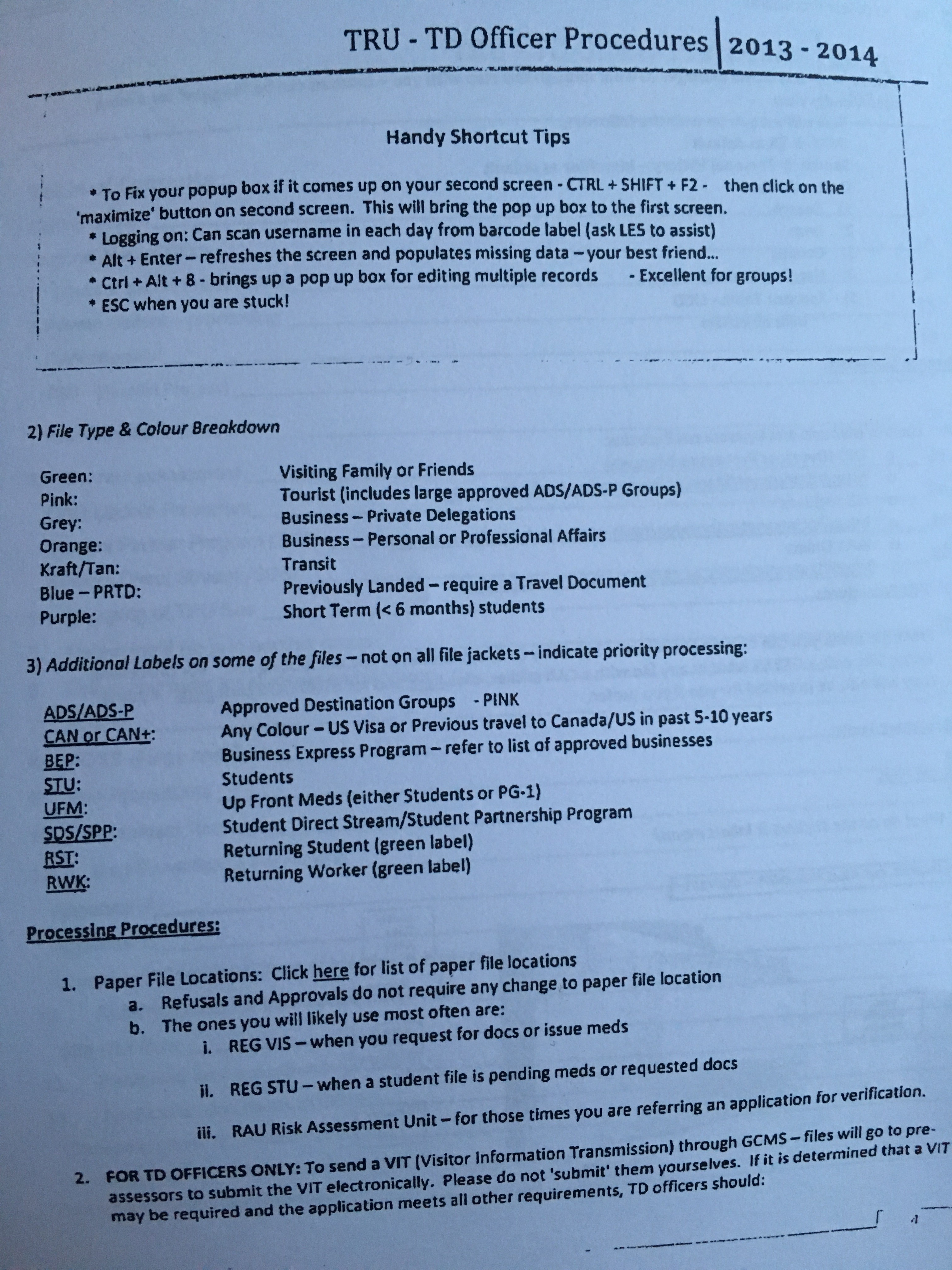Recently, my colleague Steven Meurrens uncovered via Access to Information and Privacy Request officer training guides used by Immigration, Refugee and Citizenship Canada (“IRCC”) Beijing’s Temporary Resident Unit from 2013-2015.
These guides are enlightening, opening our eyes to the inner workings of an overseas visa office. While I won’t share the entire ATIP here, the pages range from discussion on officer working hours, to how to organize files, and importantly how to prescreen and assess temporary resident applicants.
Steve broke the scoop by tweeting the following:
IRCC training manual states that borderline visa cases from the following Chinese provinces will likely be refused. pic.twitter.com/7h180tZ9tV
— Steven Meurrens (@smeurrens) July 13, 2016
I followed with another tweet, disclosing a few more pages providing greater insight into the way Chinese applicants were viewed by region:
Per @smeurrens, 2015 training guide adds Tianjin/Hunan. Total 7 places where applicant genuineness high risk #cdnimm pic.twitter.com/qeBgUnd1tT
— Will Tao|陶维 (@TheWillTruth) July 13, 2016
Yesterday, I was interviewed by Ming Pao Newspaper to share my views on the content. The Ming Pao piece (in Mandarin) has so far stirred a lot of reaction within the Chinese community as individuals debate whether IRCC’s practices are fair in this regard.
I want to take the context of this situation outside of just the Chinese community a little, and share a few more tidbits and why I think this training guide opens up a vulnerability in IRCC’s decision-making process that may face judicial challenges moving forward.
Whether or not files are re-opened because of the revelation that regional discrimination is taking place is beyond the scope of this post, However, I certainly want to also express my position that regionalism, regional or geographic discrimination, is likely not a reasonable basis for refusal that can be relied on by Canadian immigration officers moving forward. However, at the same time, I question whether it is inevitable given the already inherent biases of our Temporary Resident Visa regime.
What We Learned From the ATIP Results
The above map is very important and telling. As I mentioned in my initial tweet, this map is from a training guide titled 2015 while the one Steve posted earlier was from 2013- 2014. The 2014 one is important for the line that states “40% of claimants (I am assuming this means IRCC applicants) were from the provinces Liaoning, Guangdong, Hebei, Fujian, and Henan. It states further that “borderline” cases should be refused.
The 2015 map is revealing in that it appears to add even more specific detail. In addition to the four above it adds Tianjin (a special economic zone in Northern China) and the province of Hunan. Because of the black and white nature of the ATIP results we cannot see the entire colour scale of the map which in addition to the circled “risk provinces” appears to show a sliding scale of risk.
The side note states that the risk is in regard to “genuineness” which taking it a step further can equate to risk of misrepresentation. Misrepresentation as we know caries with in a 5-year bar and exclusion order and is a finding that often affects Chinese applicants who often times are poorly represented by incompetent counsel.
Overall, as per this chart, these are the provinces where applicants are presumed to have a greater likelihood to be misrepresenting on their applications.
We receive even further insight from the chart below which set out numerically what the risks are.
What is fascinating in the above chart is that different cities within the provinces across China are giving numbers reflecting the risk. Again, we don’t have access to the exact scale or the process by which the numbers are assigned.
However, extrapolating the fact that Beijing and Suzhou receives high numbers and the cities that are/are not redacted, we can assume the higher the number, the lower the risk. The redacted portions therefore reflect therefore the riskiest regions as aligning with the “group of seven” high risk regions.
We also can deduce through this chart what each of the colours and categories represent.
While the above is unfortunately redacted for colour, we see here on another page how the colour coding system works.
Breaking down the categories further
- Green = Visiting families or Friends
- Pink = Tourist (includes large approved ADS/ADS-P Groups)
- Green = Visiting Family or Friends
- Grey = Business – Private Delegations
- Orange = Business – Personal or Professional Affairs;
- Krat/Tan = Transit
- Blue – PRTD = previous landed – require a Travel Document
- Purple: Short Term (<5 months) students.
Below the labels clarify further that
- CAN + are individuals with a U.S visa or Previous travel to Canada/US in past 5-10 years.
Here we can assume the increased risk label in the chart is put on perceived “tourists” from Tianjin, Hebei, Liaoning, Jilin etc and “private delegations/business” from same.
Notwithstanding the above, the training materials themselves clarify that Beijing’s approval rate is 87% – giving the perception that this is to be a standard to be met.
Where is the “Genuineness” and “Risk Evidence” coming from?
The first question that pops up is where the evidentiary burden behind this. As IRCC trains their officers and provides them a global map and provinces that they should look out for- what would the answer be if a trainee officer asked – “why Hunan over Yunan?”
Does IRCC have in its coffers a master statistics list of applicants and their hometowns, number of refusal per hometown, and results on appeal?
In the alternative, could the entire basis for the risk factors be on the ground anecdotal data.
What is striking about the list for China is that the regions that are highlighted as being at risk for genuineness are also among the provinces that receive the most regional discrimination from Chinese within China.
For example. the prejudice felt by individual from the central provinces of Henan and Hebei have been covered frequently in Chinese media. See here for example and Dan Harris’s China Law Blog post on regional employment discrimination here.
Is the Chinese media potentially feeding into these perceptions? I don’t find it ironic that within China, I also hear from individual’s on the street similar regional biases to the “dongbeiren” of the North for being more aggressive and harder to deal with, or the “central chinese” as being farmers, or the Cantonese being “shady.” How much are these stereotypes (purely prejudicial comments with no factual basis) seeping into Chinese policy?
Presence of Global Risk Tiering Chart
The Global Risk Tiering chart is fascinating. Each city appears to have a country code and the codes appear to be hundreds of numbers off assuming there are more than just the list here. The ORG/Entity classification code appears to mirror almost a Designated Learning Institute Code.
If I were to select Jalandhar, Manila, or Tehran would I get results? Would there be a similar number system?
Are these practice utilized by Beijing in their visa office unique to the visa office or shared across different visa offices? Particularly, in this day and age where applicants primarily apply online and IRCC has the ability to process in Canada or send abroad to any visa office, what roles do the risk tiering chart play (potentially in place of on the ground knowledge)?
What if I am from a “genuineness” risk Province and my application is refused?
If these cases where positive and negative temporary residence factors both exist and the difference maker is based on the province the applicant is from, I would argue procedural fairness and reasonableness issues both may be triggered in challenging refusals.
From a procedural fairness perspective, I would argue that this risk tiering chart would be considered extrinsic evidence not available to the Applicant. It could not be reasonably expected that the Applicant is aware that their region of residence is particularly at risk unless the charts were made public (which would have never occurred but for this ATIP). A lack of genuineness if equated to a “lack of credibility” may also trigger the requirement for concerns to be put directly to the Applicant rather than immediately refusing as the training guide suggests. If refused, the Applicant could argue that they were not given a reasonable opportunity to respond to the credibility issues.
From a reasonableness standard, as highlighted by the recent decision of the Supreme Court of Canada in Kanthasamy, it is not reasonable, and a fettering of discretion, to treat IRCC policy as a legal standard.
So far, issues such as travel history (which cannot be a stand-alone reason for refusal) have been tied into the issue of ties to the home country as a permissible contributor to refusals. I would suggest that regionalism as a factor for refusal begins to create major challenges for IRCC as it would be difficult to link the fact an applicant is from a certain part of a country as evidence that they would not leave Canada or would not comply with the terms of their stay in Canada. I think fettering discretion is a serious consideration in these cases.
Conclusion
As I mentioned in the Ming Pao piece, I see this ATIP as the tip of the iceberg. I have a feeling that there may be grounds for opening several files to look at how the temporary resident factors were balanced in the decision.
Remember the law states:
Obligation on entry
20(1) Every foreign national, other than a foreign national referred to in section 19, who seeks to enter or remain in Canada must establish,
(a) to become a permanent resident, that they hold the visa or other document required under the regulations and have come to Canada in order to establish permanent residence; and
(b) to become a temporary resident, that they hold the visa or other document required under the regulations and will leave Canada by the end of the period authorized for their stay.
By treating applicants from certain countries differently and even breaking it down further, certain provinces within countries differently – there is an inherent bias that does not seem aligned with the nature and spirit of Canada’s immigration system.




